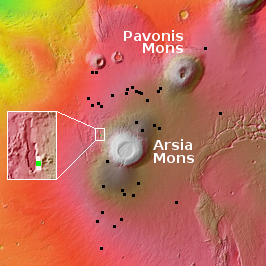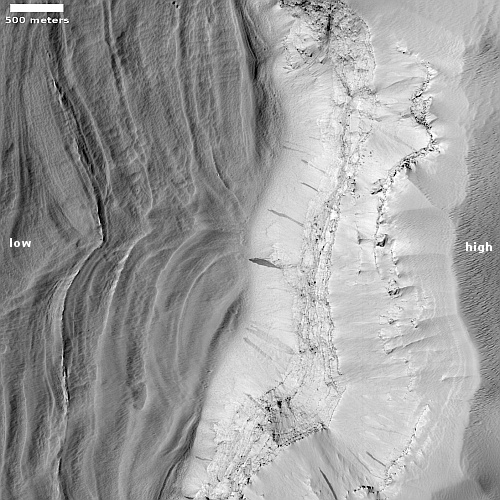The first glacial evidence found on Mars back in 2007
Cool image time! The picture to the right, cropped, reduced, sharpened, and annotated to post here, was taken on January 3, 2023 by the high resolution camera on Mars Reconnaissance Orbiter (MRO). It shows the eastern wall of what the scientists call a graben, a large depression caused when the ground inside the depression suddenly shifted downward.
The elevation difference between the high and low points is about 3,500 feet. The streaks on the lower half of the cliff wall are slope streaks, a phenomenon unique to Mars that remains at this moment unexplained. Though the streaks resemble avalanches, they do not change the topography in any way, have no debris pile at their base, and appear instead to be a stain that appears at random times of the year that fades with time.
What is intriguing about this picture however is the wavelike floor on its western half. At first glance these waves suggest some form of dust dunes or lava flows, but neither conclusion appears correct. Instead, we are looking at what was one of the first discoveries on Mars of what scientists have determined to be glacial features.

Click for original image.

The green dot in the inset on the overview map to the right marks the location of this picture, on the northwestern flanks of the giant volcano Arsia Mons. The black dots mark the locations of pits — likely skylights into lava tubes — that have been featured as cool images previously. The MRO context camera image above, taken on January 21, 2007 and rotated so north is to the right, provides a full view of the entire graben depression, with those waves of material clearly appearing to flow to the north.
While the waves of material and their location on this giant volcano suggest they might be lava that filled the graben depression, a 2007 science paper using MRO images instead concluded that this material was an aging glacier covered with debris.
After detailed review of new observations, we interpret the fill material on the floor of the large graben at Arsia Mons to be waning stages of debris-covered glaciers that filled the graben in the past. The collections of ridges and furrows on the fill surface suggest that the two alcoves on the southeastern wall of the graben served as the accumulation areas for two large debris-covered glaciers that were the primary source of ice within the graben (Figures 3 and 4). Corresponding patterns of ridges and ridge packets on each of these glaciers (Figure 4) suggest that they formed simultaneously in the two cirque-like alcoves, with the same atmospheric source, and flowed northward along the long axis of the graben.
The paper from which I quote was one of the first that identified what appeared to be glacial features on Mars, here on the western flanks of Arsia Mons. Since then scientists have used MRO to take repeated pictures of the floor of this graben, monitoring it for changes. Unfortunately, the best images easily downloadable on the web do not have the resolution necessary for me to identify any changes, and I have not been able to find any more recent papers studying this graben. Since most of the glaciers on Mars are generally considered inactive, it is likely that this is the situation here as well.
The seasonal appearance of a long cloud originating over the western flanks of Arsia Mons however does suggest the possibility that these glaciers are shrinking, their ice sublimating into gas each year to form that cloud.
On Christmas Eve 1968 three Americans became the first humans to visit another world. What they did to celebrate was unexpected and profound, and will be remembered throughout all human history. Genesis: the Story of Apollo 8, Robert Zimmerman's classic history of humanity's first journey to another world, tells that story, and it is now available as both an ebook and an audiobook, both with a foreword by Valerie Anders and a new introduction by Robert Zimmerman.
The print edition can be purchased at Amazon or from any other book seller. If you want an autographed copy the price is $60 for the hardback and $45 for the paperback, plus $8 shipping for each. Go here for purchasing details. The ebook is available everywhere for $5.99 (before discount) at amazon, or direct from my ebook publisher, ebookit. If you buy it from ebookit you don't support the big tech companies and the author gets a bigger cut much sooner.
The audiobook is also available at all these vendors, and is also free with a 30-day trial membership to Audible.
"Not simply about one mission, [Genesis] is also the history of America's quest for the moon... Zimmerman has done a masterful job of tying disparate events together into a solid account of one of America's greatest human triumphs."--San Antonio Express-News
Cool image time! The picture to the right, cropped, reduced, sharpened, and annotated to post here, was taken on January 3, 2023 by the high resolution camera on Mars Reconnaissance Orbiter (MRO). It shows the eastern wall of what the scientists call a graben, a large depression caused when the ground inside the depression suddenly shifted downward.
The elevation difference between the high and low points is about 3,500 feet. The streaks on the lower half of the cliff wall are slope streaks, a phenomenon unique to Mars that remains at this moment unexplained. Though the streaks resemble avalanches, they do not change the topography in any way, have no debris pile at their base, and appear instead to be a stain that appears at random times of the year that fades with time.
What is intriguing about this picture however is the wavelike floor on its western half. At first glance these waves suggest some form of dust dunes or lava flows, but neither conclusion appears correct. Instead, we are looking at what was one of the first discoveries on Mars of what scientists have determined to be glacial features.

Click for original image.

The green dot in the inset on the overview map to the right marks the location of this picture, on the northwestern flanks of the giant volcano Arsia Mons. The black dots mark the locations of pits — likely skylights into lava tubes — that have been featured as cool images previously. The MRO context camera image above, taken on January 21, 2007 and rotated so north is to the right, provides a full view of the entire graben depression, with those waves of material clearly appearing to flow to the north.
While the waves of material and their location on this giant volcano suggest they might be lava that filled the graben depression, a 2007 science paper using MRO images instead concluded that this material was an aging glacier covered with debris.
After detailed review of new observations, we interpret the fill material on the floor of the large graben at Arsia Mons to be waning stages of debris-covered glaciers that filled the graben in the past. The collections of ridges and furrows on the fill surface suggest that the two alcoves on the southeastern wall of the graben served as the accumulation areas for two large debris-covered glaciers that were the primary source of ice within the graben (Figures 3 and 4). Corresponding patterns of ridges and ridge packets on each of these glaciers (Figure 4) suggest that they formed simultaneously in the two cirque-like alcoves, with the same atmospheric source, and flowed northward along the long axis of the graben.
The paper from which I quote was one of the first that identified what appeared to be glacial features on Mars, here on the western flanks of Arsia Mons. Since then scientists have used MRO to take repeated pictures of the floor of this graben, monitoring it for changes. Unfortunately, the best images easily downloadable on the web do not have the resolution necessary for me to identify any changes, and I have not been able to find any more recent papers studying this graben. Since most of the glaciers on Mars are generally considered inactive, it is likely that this is the situation here as well.
The seasonal appearance of a long cloud originating over the western flanks of Arsia Mons however does suggest the possibility that these glaciers are shrinking, their ice sublimating into gas each year to form that cloud.
On Christmas Eve 1968 three Americans became the first humans to visit another world. What they did to celebrate was unexpected and profound, and will be remembered throughout all human history. Genesis: the Story of Apollo 8, Robert Zimmerman's classic history of humanity's first journey to another world, tells that story, and it is now available as both an ebook and an audiobook, both with a foreword by Valerie Anders and a new introduction by Robert Zimmerman.
The print edition can be purchased at Amazon or from any other book seller. If you want an autographed copy the price is $60 for the hardback and $45 for the paperback, plus $8 shipping for each. Go here for purchasing details. The ebook is available everywhere for $5.99 (before discount) at amazon, or direct from my ebook publisher, ebookit. If you buy it from ebookit you don't support the big tech companies and the author gets a bigger cut much sooner.
The audiobook is also available at all these vendors, and is also free with a 30-day trial membership to Audible.
"Not simply about one mission, [Genesis] is also the history of America's quest for the moon... Zimmerman has done a masterful job of tying disparate events together into a solid account of one of America's greatest human triumphs."--San Antonio Express-News


